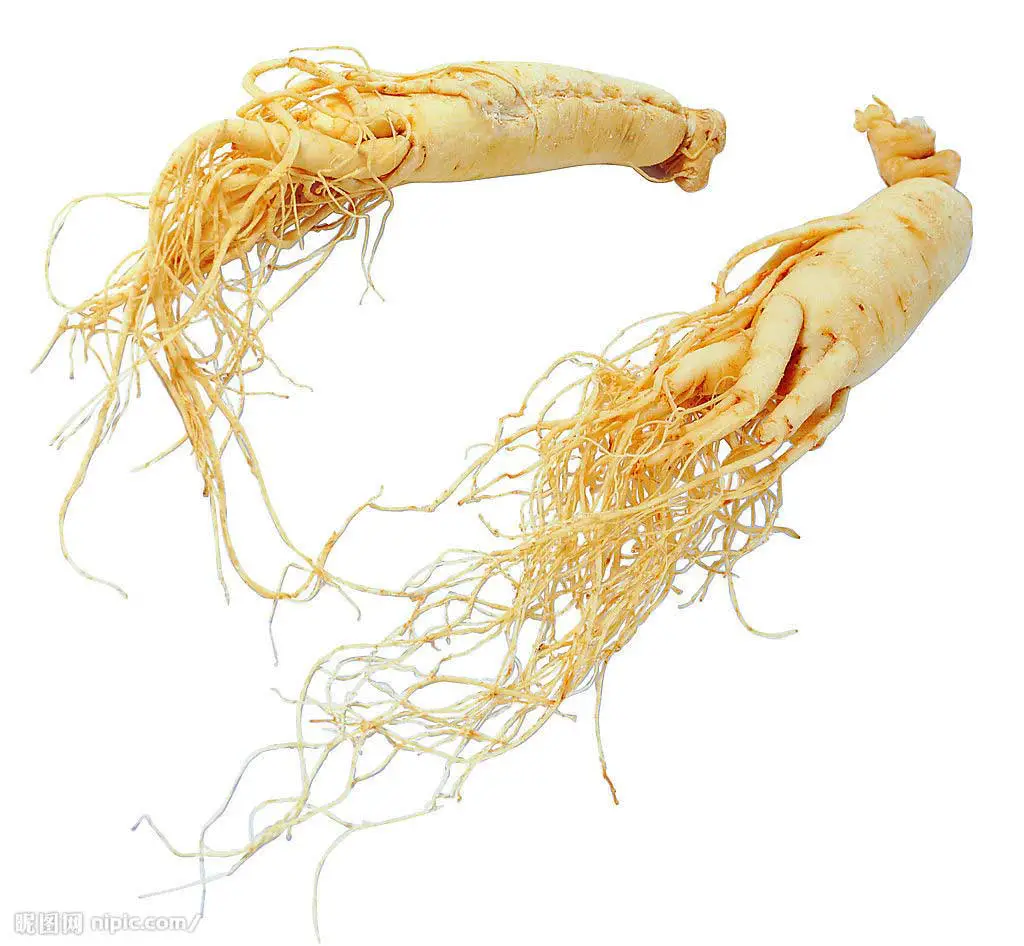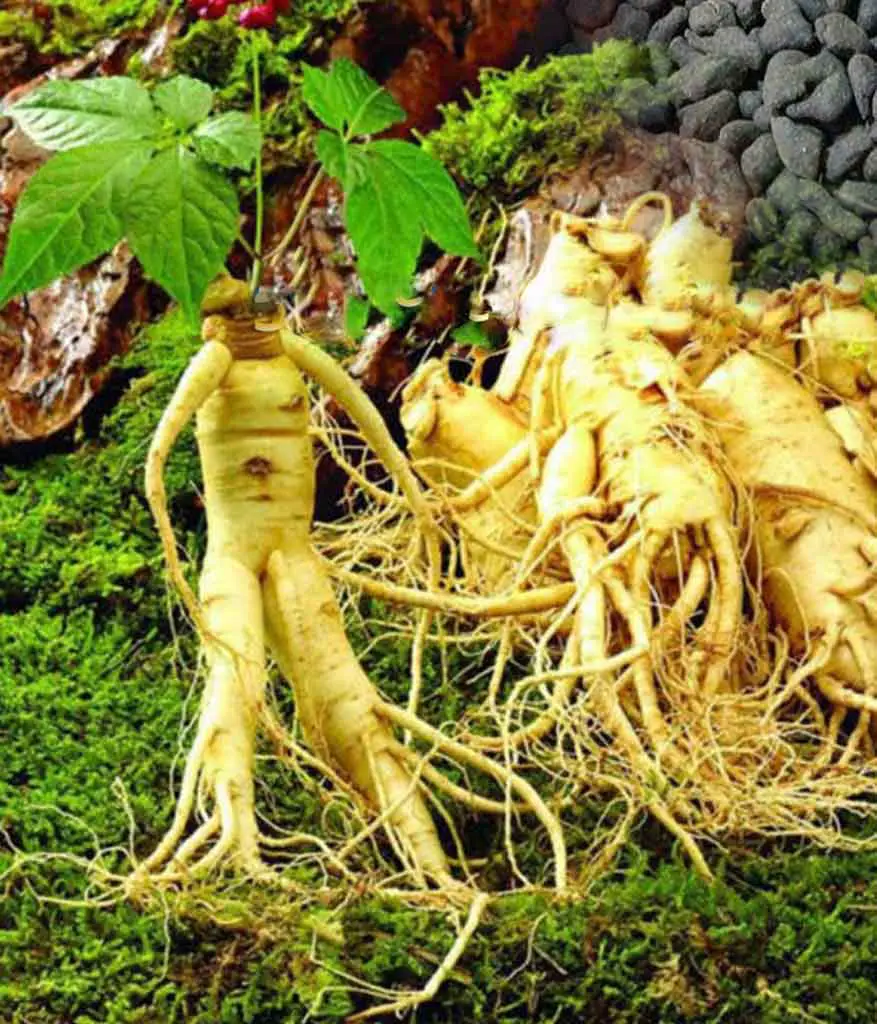What is Korean Red Ginseng?
Korean Red Ginseng is a member of the Panax Ginseng family, which has been one of the most widely used natural medical treatments in the world for treating a wide variety of illnesses from erectile dysfunction to cancer. Ginseng has played an important role in Asian culture since at least the turn of the millennium. Our first records of Korean Red Ginseng come from approximately 1000 A.D., during which time the Goryeo dynasty was undergoing massive efforts on agricultural revitalization of the country. Ginseng is one of the most valuable resources in Asia. Empires have risen and fallen because of it. The plant was often reserved in the ancient world for those that could actually afford it, which not everyone could. Even in modern society, the plant is remarkably valuable, with roots of the plant being sold at uniquely high prices.
Appearance/Taste: When you see Korean Red Ginseng, it is not much taller than your forearm, measuring only about two feet high, with thick, short roots. The leaves are single-pronged, measuring roughly 6 inches in length and the berries of the ginseng plant rest on top, colored a bright red.
Looking at the plant, it might be easy to think that the berries are the desirable part of the plant – that they would make a sweet elixir. Much to everyone’s chagrin, the medicinal properties of the ginseng plant come from the root and bark of the plant, which are ground up and then administered in a couple of different ways. On most accounts, raw ginseng tastes earthy and spicy. How it tastes largely depends on where it comes from. Most traditional teas made with ginseng fully embrace the earthiness of the drink, whereas variations with a more western market, have been sweetened accordingly. This makes ginseng far more applicable, as far as natural remedies go, as it can be used on a wider variety of patients. This is especially true when thinking about medicine for children, who are usually a bit fussier about taste.
How does Korean Red Ginseng differ from Panax Ginseng?
Korean Red Ginseng is different from Panax ginseng mainly in terms of its preparation. Traditional ginseng is made by washing and drying the plant, while Korean Red Ginseng is created through a unique process of steaming the root, which gives it the red coloration by which it is named after. In addition to the coloration, this process allows the herb to acquire unique medicinal qualities that make it such a highly sought-after homeopathic treatment.
Korean Red Ginseng Benefits and Uses
Ginseng has several uses and can be applied to treat a variety of different conditions. The product can be used to improve the immune system, strengthen cardiac health, treat diabetes, and it boosts overall energy. These uses are what made Ginseng such a prominent medical treatment in ancient Asian cultures prior to the time of modern medicine, and it is largely what makes the herb such an attractive homeopathic option today for those looking to avoid a costly visit to the doctor.
Now lets answer the question: “What is Ginseng good for?”
Erectile Dysfunction (ED)
Korean Red Ginseng can be used to combat impotency and erectile dysfunction. In a 2002 study published in the Journal of Urology, scientists conducted a comparative analysis of the effects of Red Korean Ginseng compared to placebos. Their findings indicated much stronger results coming from those who had taken the Ginseng than those who had taken the placebo, suggesting a legitimate effect of the herb. The study ultimately concluded that the plant is an effective means of combating erectile dysfunction through alternative means, rather than conventional medicine.
Female Arousal
One may think that Red Korean Ginseng is used mainly for male dysfunctions, but this is not true. In a 2010 study, the US National Library of Medicine points out that the effects of the herb can also be used to help women who are having difficulty experiencing arousal. Of the 28 women who participated in the study, nearly all participants who were given the plant experienced heightened sexual arousal during the two-week period over which it was conducted. Similar to the study on male effects, the scientists in charge of conducting the experiment deemed it a success and argued that Korean Red Ginseng can be used as a potential alternative medicine to improve the sexual libidos of women.
Cancer
Korean Red Ginseng has been known to help cancer patients, both in terms of pain management, as well as actually fighting the disease itself. In a 2013 article published by the US national Library of Medicine, scientists suggest that the use of Korean Red Ginseng actually helps stop the spread of the disease. The abstract reads that “Asian Ginseng exhibits anti-proliferative effects on HCT116 cells and reduces tumor sizes in a xenograft model.” Although significantly more research needs to be done on the herb to further test these properties, the use of Korean Red Ginseng could have potential implications in the future years of the fight against cancer. One study suggests that the anti-cancer effects of Ginseng is “imperative” in the near future.
Antioxidant
In study of rats Korean Red Ginseng was found to reduce oxidative stress as well as restore antioxidant capacity. Aged rats have a higher level of MDA in the liver, kidney, hearts and lungs when compared to young rats. Other studies have concluded this is indicative of excessive free radicals. Korean Red Ginseng provided a significant decrease in the levels of MDA in the live, kidneys, heart and lungs. The study concludes, this is due to the antioxidants present in Korean Red Ginseng.
Heart
In a small study of 45 people Korean Red Ginseng showed promising treatment for Heart Failure and its mechanism. It’s results were even considered better than a popular heart drug called Digoxin. However; considering it’s an extremely small study more are needed.
Skin
Ginseng has shown comparable treatment to some steroids when it comes to skin diseases, including contact dermatitis. The best part is, Ginseng doesnt have many if any side effects while steroids have significant ones.
Anti Aging
In a study published in the Journal of Medicinal Food Korean Red Ginseng has shown preventative activities against tyrosinase and elastinase. Type I collagen and gibroectin were also stimulated. In this same study Korean Red Ginseng also indicated that it fights free radicals.
Memory
There a multiple animals studies that show Korean Red Ginseng has cognitive benefits in animals. While this is positive, in a small study on humans (15 people) the same benefits were not noted. However; anecdotally there has been significant people that report cognitive enhancement.
Immune Booster
Ginseng is well regarded in multiple studies as a herb that stimulates the immune system. It shows promise supporting NK cells comparative to placebo even in people with broken down immune systems.
Anti-Inflammatory
Ginseng reduces the production of pro-inflammatory cytokines.
Stress
There might be a host of other benefits as were just scratching the surface when it comes to researching Korean Red Ginseng. There is evidence to suggest Korean Red Ginseng is a natural mood stabilizer. There is also promise that Korean Red Ginseng is a AMPK Activator.

Korean Red Ginseng Dosage
Korean Red Ginseng is distinct from typical ginseng, mainly in terms of its preparation. The end result comes from a process of washing, steaming, and then drying the herb in the sun. Most herbalists recommend taking anywhere from 200mg-400mg of the herb daily, either via tea or capsules, which can be purchased online for relatively cheap. The amounts, of course, vary depending on the potency of the Ginseng itself. Often times, the herb will be mixed with other substances for the sake of flavoring or treating other ailments that the ginseng is meant to act with, such as Polygala or Hoelen.
Due to its widespread use, Ginseng is offered via several different methods. The roots of the plant are sometimes cut up and served raw in thin slices for a light snack. Once properly dried, the root can also be ground up into a fine powder for consumption. In particular, this method is best used for those with a weak digestive system, making it an ideal system for those attempting to use Ginseng to overcome a common cold or even the flu. Further yet, the herb can be fermented into a tincture mixture, which will be far more potent than any of the other methods. Nonetheless, the most common method by far is the use of ginseng tea.
Which of these methods will work best for you really depends on your situation. If you are feeling sick or even nauseous, I would recommend either the powder or the tea, as both are ideal for those with weak digestive systems. Tincture mixtures are always going to be the most potent, but might not be as readily available as ginseng tea. Liquid extracts of the Korean Red Ginseng can also be purchased in capsules for easier consumption, but these capsules are not always readily available.
Korean Red Ginseng Side Effects
While Korean Red Ginseng has remarkable health benefits when taken in the correct doses, there are relatively minor dangers to taking the herb. For example, the study on women’s libidos also noted two instances of vaginal bleeding in the test subjects of their experiment. This was not due to the herb itself, but to an improper dosage. This appears to be the primary cause of all side effects. The most common effect of the herb is sleeplessness, but it can also include elevated blood pressure, diarrhea, rashes, and occasional menstrual issues for women.
Please note: While the effects of Korean Red Ginseng can be powerful, especially in more potent delivery systems, they are nonetheless not a substitute for real medical professionals. I advise these treatments as a means of preventative medicine and even initial curative treatments, but they will not suffice in the event of a medical emergency.
In short, if you want to be safe about Ginseng don’t take too much, and don’t take it for an extended period of time.
Best Korean Red Ginseng
When it comes to supplements there are a lot of ineffective ones out there. This is mainly due to incorrect preparation and it’s not different when it comes to Korean Red Ginseng. There are a lot of supplement companies selling non-fermented Korean Red Ginseng which doesn’t allow bio-availability. There is currently only one or two Korean Red Ginseng’s on the market that I would recommend at this point.
It is imperative you use a Fermented Korean Red Ginseng as opposed to a non-fermented version.
Why take fermented Korean Red Ginseng?
- Fermented Korean Red Ginseng has significantly higher polyphenol content.
- Fermented Korean Red Ginseng has much more antioxidant power.
- Fermented Korean Red Ginseng has much higher ginsenoside metabolites.
- Fermented Korean Red Ginseng has better skin permeability.
- Fermented Korean Red Ginseng, works, non-fermented doesn’t.
It’s evident that a Red Ginseng that is fermented is noticeably better than a non fermented version. In fact, almost all studies that show benefits of Korean Red Ginseng are done with a fermented version. There are studies that suggest that non-fermented versions, dont work, while fermented versions do. If you buy a non-fermented version you’re either depending on the placebo effect or just hoping it works.
References:
https://www.ncbi.nlm.nih.gov/pmc/articles/PMC3659629/
https://www.ncbi.nlm.nih.gov/pmc/articles/PMC3491619/
https://www.ncbi.nlm.nih.gov/pubmed/7549378/
http://www.sciencedirect.com/science/article/pii/S0271531712001662?via%3Dihub
http://www.sciencedirect.com/science/article/pii/S1226845315000068
https://www.ncbi.nlm.nih.gov/pmc/articles/PMC3659612/





